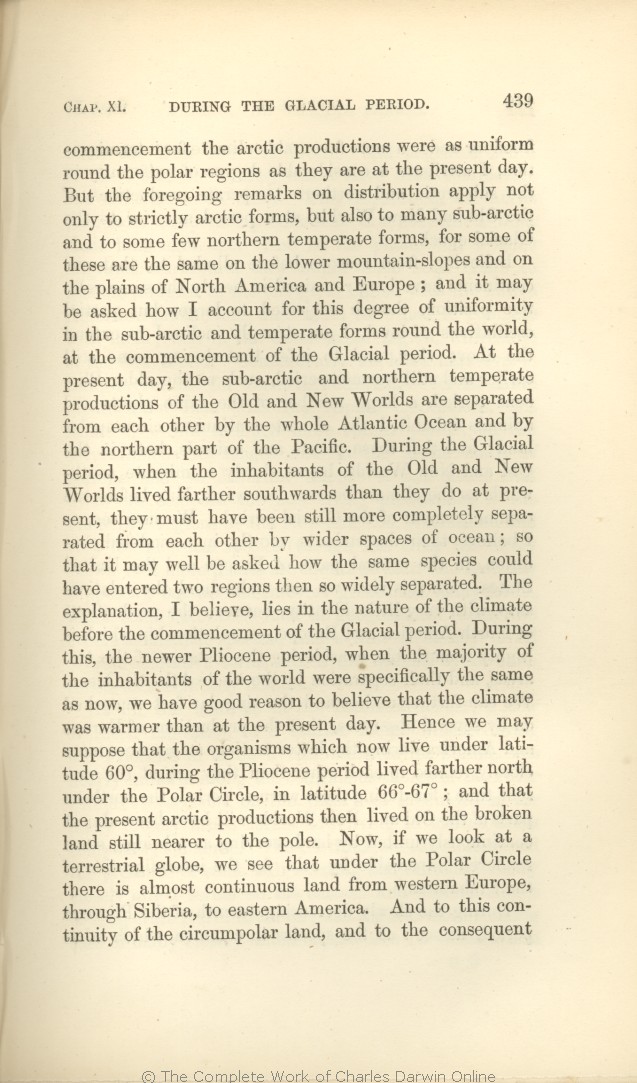the | the 1859 1860 1861 1866 |
| of our imaginary Glacial period, the 1869 1872 |
| the foregoing remarks on distribution apply not only to strictly arctic forms, but also to 1859 1860 1861 1866 |
| it is necessary also to 1869 |
| it is also necessary to assume that 1872 |
| many 1859 1860 1861 1866 1872 | | include many 1869 |
| to 1859 1860 1861 1866 | to 1869 1872 |
| northern 1859 1860 1861 1866 | northern 1869 1872 |
| forms, 1859 1860 1861 1866 1869 | | forms 1872 |
| for some of these are 1859 1860 1861 1866 1869 |
| were 1872 |
| on 1859 1860 1861 1866 1869 | | round 1872 |
| lower mountain-slopes and 1866 1869 |
| lower mountains and 1859 1860 1861 |
| world, for some of the species which now exist 1872 |
| plains 1859 1860 1861 1866 1869 |
| lower mountain-slopes and on the plains 1872 |
| Europe; 1859 1860 1861 1866 1869 | | Europe 1872 |
| and 1859 1860 1861 1866 1869 |
| are the same; and 1872 |
| ..... 1866 1869 1872 | | reasonably 1859 1860 1861 |
| this 1866 1869 1872 | | the necessary 1859 1860 1861 |
| in 1866 1869 1872 | | of 1859 1860 1861 |
| ..... 1866 1869 1872 | | northern 1859 1860 1861 |
| Glacial 1859 1860 1861 1866 | | real Glacial 1869 1872 |
| whole Atlantic 1866 1869 1872 | | Atlantic 1859 1860 1861 |
| ..... 1866 1869 1872 | | extreme 1859 1860 1861 |
| ..... 1860 1861 1866 1869 1872 | | in- 1859 |
| inhabitants 1860 1861 1866 1869 1872 | | habitants 1859 |
| farther 1861 1866 1869 1872 | | further 1859 1860 |
| they do at 1866 1869 1872 |
| at 1859 1860 1861 |
| from each other by 1866 1869 1872 |
| by 1859 1860 1861 |
| ocean; so that it may well be asked how the same species could have entered two regions then so widely separated. 1866 |
| ocean. 1859 1860 1861 |
| ocean; so that it may well be asked how the same species could have entered the two continents then so widely separated. 1869 |
| ocean; so that it may well be asked how the same species could then or previously have entered the two continents. 1872 |
| 2 blocks not present in 1866 1869 1872; present in 1859 1860 1861 | | I believe the above difficulty may be surmounted by looking to still earlier changes of climate of an opposite nature.
We have good reason to believe that during the newer Pliocene period, before the Glacial epoch, and whilst the majority of the inhabitants of the world were specifically the same as now, the climate was warmer than at the present day.
|
| which now live under latitude 60°, 1866 |
| now living under the climate of latitude 60°, 1859 1860 1861 |
| which now live under latitude 60°, lived 1869 |
| which now live under latitude 60°, 1872 |
| during the Pliocene period lived 1859 1860 1861 1866 |
| during the Pliocene period 1869 |
| lived during the Pliocene period 1872 |
| father 1866 | | further 1859 1860 | | farther 1861 1869 1872 |
| 66°-67°; 1866 1869 | | 66°-67°; 1859 1860 1861 1872 |
| present 1866 1869 1872 | | strictly 1859 1860 1861 |
| Now, 1866 1869 1872 | | Now 1859 1860 1861 |
| terrestrial globe, we see that 1866 |
| globe, we shall see that 1859 1860 1861 |
| terrestrial globe, we see 1869 1872 |
| there 1859 1860 1861 1866 | | that there 1869 1872 |
| to 1859 1860 1861 1866 | to 1869 1872 |
| and to 1859 1860 1861 1866 | | with 1869 1872 |
|









